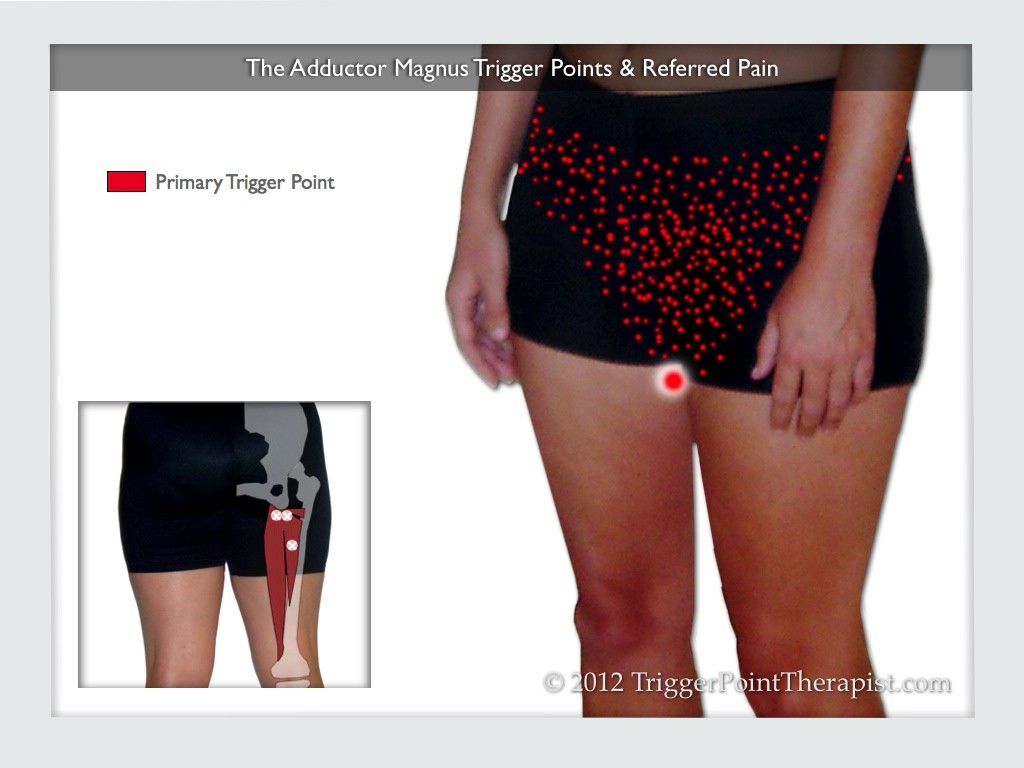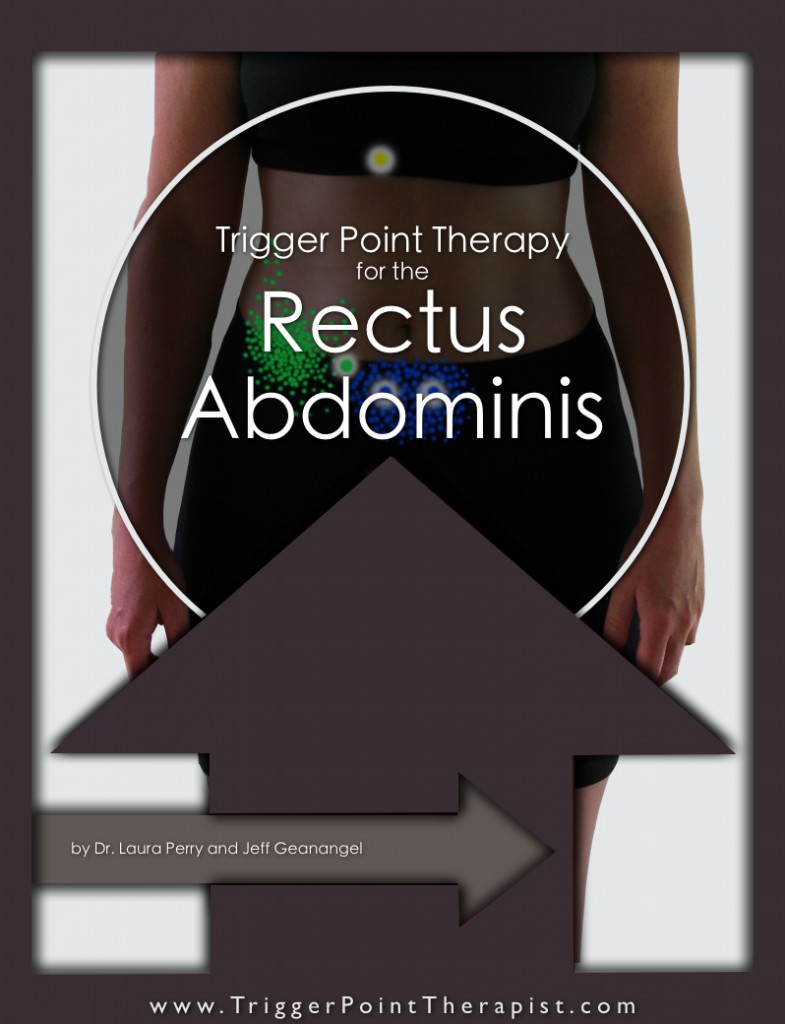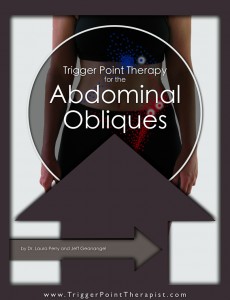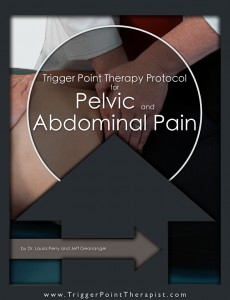Would you believe me if I told you that the monthly scourge that disrupts the lives of women everywhere could be easily beaten back with a simple trigger point therapy technique? If you are a woman, probably not. (If you are a man, well your opinion just doesn’t matter in this situation, ha ha.)
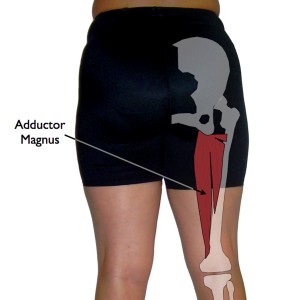 It’s true. The pelvic cramping and aching associated with premenstrual syndrome is largely expressed by a trigger point in the adductor magnus muscle. And if you commonly experience pelvic and/or vaginal pain after intercourse, this trigger point is to blame too.
It’s true. The pelvic cramping and aching associated with premenstrual syndrome is largely expressed by a trigger point in the adductor magnus muscle. And if you commonly experience pelvic and/or vaginal pain after intercourse, this trigger point is to blame too.
I didn’t believe it either. Having suffered for many years with horrible pain from endometriosis, I openly mocked my husband when he suggested that we look for a myofascial component of my pain. We did and guess what? It worked!
Since then I have treated this trigger point on many of my female patients, often as supplementary treatment, and had good success with it. The adductor magnus trigger point isn’t the only trigger point that can be involved in pelvic pain complaints, so I developed the Pelvic & Abdominal Pain Protocol to deal with the more complex cases.
And so as not to leave the men out of this conversation, this trigger point seems also to be a major player in testicular pain. I’ve only seen a couple of the cases of testicular pain but the results that I got were very promising.
I also frequently address this trigger point in stubborn cases of hip pain, groin pain, hamstring tightness, and low back pain. However, it will always be the “PMS trigger point” to me.
The Adductor Magnus Muscle
Location: As its name suggests, the adductor magnus is the largest of the adductor muscle group. It lies deep along the inside aspect of the thigh, sandwiched between the hamstrings and quadriceps.
Function: This muscle functions primarily to control the placement of bodyweight during the heel-strike phase of walking. Together with the hamstrings, it also acts to help maintain the upright posture by counteracting the tendency of gravity to produce forward flexion of the trunk at the hips.
Muscle Structure: The adductor magnus has three distinct sections. or muscle bellies.
- The upper section is the smallest and its fibers run almost horizontally from the pubic bone (Inferior pubic ramus) to attach on the femur just below the lesser trochanter. It is sometimes referred to as the adductor minimus.
- The middle section has a fan shaped structure that originates at a point on the inferior ramus of the pelvis and expands (fan-outs) distally to attach along the upper two thirds of the shaft of the femur (along the linea aspera).
- The posterior section of the adductor magnus is the largest of the three sections and its fibers run downward from the ischial tuberosity (the “sits- bone”) to attach to the medial condyle of the femur just above the knee joint.
Muscle Actions: Contraction of the adductor magnus produces adduction and medial rotation of the thigh at the hip. The posterior section of this muscle assists the hamstring muscle group in producing extension of the thigh at the hip.
Synergistic Muscle Groups: The following muscle groups share common biomechanical functionality with the adductor magnus and may become overloaded if it’s unable to perform its workload due to trigger point activity or injury:
- The adductor group (adductor longus and adductor brevis), pectineus, and gracilis work together with the adductor magnus to produce adduction of the thigh at the hip.
- During medial rotation of the thigh at the hip, the adductor magnus is assisted by the adductor group and the anterior fibers of the gluteus minimus.
- The adductor magnus is highly synergistic with the hamstrings during extension of the thigh at the hip.
Antagonistic Muscle Groups: The following muscles oppose the movements produced by the adductor magnus and may develop trigger point activity in response to neurological distortions.
- Adduction of the thigh is opposed by the tensor fascia latae, gluteus medius, and gluteus minimus muscle groups.
- Medial rotation of the thigh is opposed by the gluteus maximus and ilio-psoas.
The Adductor Magnus Trigger Points
As shown in the diagram below, there are three potential trigger points in the adductor magnus muscle:
- The two upper trigger points are found just below the attachments to the ischial tuberosity. Although Travell and Simons report an upper trigger point in both the middle and posterior divisions of the muscle, a therapist is unlikely to be able distinguish these trigger points from one another in practice. Therefore, I treat both trigger points as one trigger point.
- The lower trigger point is found in the middle division of this muscle near the midpoint of its attachment to the femur.
Typically, I don’t find the lower trigger point to be clinically relevant in most cases involving this muscle. The pain complaints associated with the upper trigger point(s) are much more common in my practice.
Adductor Muscle Pain
The most clinically relevant trigger point in this muscle is found near its attachment to the pelvis. It may form as one or two side-by-side trigger points in the fibers of the posterior section of this muscle.
Dr. Travell reports of another trigger point found in the middle section of this muscle, but I have never seen this trigger point in my clinical practice.
These trigger points are shown in the diagram above. Please note that only the referred pain from the upper trigger point(s) is shown. The lower trigger point refers pain and tenderness down the inside of the thigh from the groin to the knee (not shown).
What Causes Adductor Trigger Points?
The following events or activities may activate or reactivate the adductor magnus trigger point(s):
- Slipping on ice or roller skates
- Skiing or roller blading
- Long bicycle trip
- Osteoarthritis of hip
- Running or walking uphill
- Sitting in a fixed position for a long period of time, such as when driving
- Sexual intercourse
- Hormonal changes associated with PMS
Adductor Magnus Symptoms & Disorders
Clients with an active adductor magnus trigger point will present with any or all of the following symptoms or clinical findings:
- a diffuse pain inside the pelvis
- vaginal pain
- testicular pain
- rectal pain
- pain during sexual intercourse
- severe PMS cramping-type pain
- groin or inner thigh pain
- a reduced range of motion (and/or pain) during abduction of the thigh.
Related Disorders
- Nerve Entrapment: Compression of the obturator or genitofemoral nevers may produce pain, numbness, and tingling sensations in the groin and medial thigh regions.
- Pubic Stress Symphysitis: Also referred to as osteitis pubis, this condition is characterized by isolated tenderness on both sides of the pubic symphysis. The pain is aggravated by sport activities and specifically by adduction and/or extension of the thighs. This condition is typically confirmed with X-ray and MRI findings.
- Pubic Stress Fracture: Sometimes seen in runners (and in marching military personnel) a stress fracture of the inferior pubic ramus (either one or both) is thought to be a overuse fracture caused by chronic tension in the adductor muscles.
- Adductor Insertion Avulsion Syndrome: Also known as “thigh splints”, is a periosteal reaction along the femur shaft where the adductor muscles attach. The pain is localized to the thigh and is relieved by rest. Chronic trigger point activity in the adductor group is likely to be present in this condition, and most likely an aggravating factor.
Treatment of Adductor Magnus Trigger Points
In my clinical practice, I most often see adductor magnus trigger points present as secondary trigger points in stubborn cases of gluteus medius, gluteus minimus, and tensor fascia latae trigger points. As the primary biomechanical antagonist to these three muscles, unaddressed trigger point activity in the adductor magnus often plays spoiler to the treatment of these hip abductor trigger points.
Click on the image below to watch the free Adductor Magnus Trigger Point video for free on YouTube.
Related Articles:
- Abdominal Oblique Trigger Points: South of the Border Pain
- Rectus Abdominis Trigger Points: A Six-Pack of Deception
- The Hamstring Trigger Points: Hiding in Plain Sight
Related Instructional Videos:
